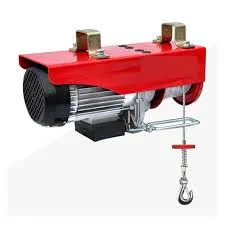


Understanding Chain Block Lever Hoists A Comprehensive Overview
Chain block lever hoists, commonly referred to as chain hoists, are essential tools in various industries, including construction, manufacturing, and warehousing. These mechanical devices utilize a system of chains and levers to lift heavy loads safely and efficiently. Understanding how they work and their applications can significantly enhance productivity and safety in the workplace.
How Chain Block Lever Hoists Work
At the core of a chain block lever hoist is its simple yet effective mechanism that combines the principles of mechanical advantage and leverage. The hoist features a durable chain that passes through a set of pulleys. When the user pulls on the lever, the motion is translated through the system of gears and pulleys, allowing the load to be lifted with minimal effort. The mechanical advantage gained through this design means that operators can lift significantly heavier weights than they could manually.
Typically, chain block lever hoists come in various load capacities, ranging from a few hundred kilograms to several tons. This versatility makes them suitable for a wide range of applications, from lifting building materials to positioning heavy machinery.
Types of Chain Block Lever Hoists
Chain block lever hoists can be categorized into manual and electric models. Manual hoists are operated by hand, involving the user pulling the lever to lift the load. These are often more portable, require no external power source, and are generally more cost-effective. Manual hoists are ideal for jobs where precision and control are necessary but do require physical effort and can be limited by the user’s strength.
Electric chain hoists, on the other hand, are powered by electricity and can handle larger loads with ease. They are designed for frequent use and can significantly enhance efficiency in environments where heavy lifting is a regular task. While they may come at a higher initial investment, their speed and reduced manual effort can lead to increased productivity over time.

Safety Features and Considerations
Safety is paramount when operating chain block lever hoists. These devices are equipped with several safety features, such as overload protection, to prevent lifting beyond their capacity, which could result in accidents or equipment failure. Additionally, proper maintenance is crucial; regular inspections of the chains, hooks, and levers ensure that the hoist remains in safe operating condition.
Operators should also be trained in the proper use of hoists, including how to calculate load weight and understand the limitations of the equipment. Wearing appropriate personal protective equipment (PPE), such as gloves and hard hats, is another essential aspect of ensuring safety during operations.
Applications of Chain Block Lever Hoists
The applications for chain block lever hoists are extensive. In the construction industry, they are used for lifting heavy beams, scaffolding, and other materials that are cumbersome and awkward to handle manually. In warehouses, hoists can be utilized for loading and unloading goods, especially in tight spaces where forklifts might not fit.
In marine applications, chain hoists help in raising and lowering boats or heavy equipment on docks. Similarly, in manufacturing, these tools are used to assemble products, move machinery, or lift components during installation.
Conclusion
Chain block lever hoists are invaluable tools that make heavy lifting safer and more efficient across various industries. Understanding their operation, types, safety features, and applications can help organizations leverage these tools to maximize productivity while minimizing the risk of injury. As technology continues to evolve, these devices will likely integrate more advanced safety features, ensuring they remain a staple in lifting equipment for years to come. Whether operating in a construction site or a factory, knowing how to properly use a chain block lever hoist is essential for every worker involved in heavy lifting tasks.



